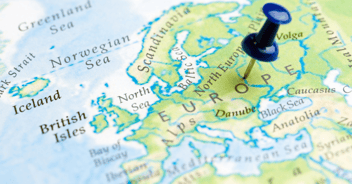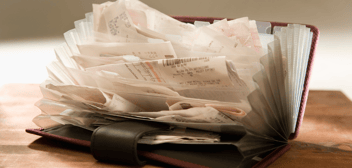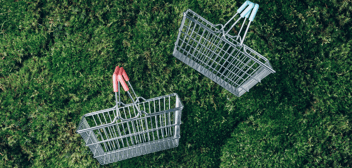
.png)
One Year On: How France’s Receipt Ban is Changing Retail for Good
In 2023, France took a bold step toward sustainability with the introduction of its ambitious Anti-Waste and Circular Economy (AGEC) law. A feature of this legislation was a groundbreaking ban on the automatic printing of paper receipts. Now, a year later, we explore how this initiative has impacted consumers, retailers, and the environment.
Firstly, why did France ban the automatic printing of receipts?
As part of their broader AGEC law to minimise waste and promote a circular economy, the banning of automatic paper receipts was introduced to reduce paper waste and the environmental impact associated with the production, printing and disposal of receipts.
Can consumers still receive paper receipts in France?
Yes, they can. Although the law stops the automatic printing of paper receipts, consumers can still request them if needed. This shift encourages a more thoughtful approach to receipt use among consumers and retailers.
What impact has the ban had on the environment so far?
Prior to the ban, France printed over 30 billion paper receipts per year. Although it’s impossible to know exactly how many receipts are no longer being printed since the new law took effect, even if it’s just a 20% decrease (and we’re being conservative here!) it would have a significant environmental impact.
We’ve calculated that it could have saved up to 15,000 tonnes of carbon* if we look at the impact of a 20% reduction in automatic receipt printing:
📉 6 billion fewer receipts printed each year.
🌍 15,000 tonnes of carbon saved, based on each receipt emitting 2.5g of CO2.
🌲 This is equivalent to the carbon absorption of 688,944 trees.
🍎 That’s 38 times the number of trees in New York’s Central Park.
✈️ It's the same as flying around the world 1,522 times.

What has been the impact on retailers?
In addition to the environmental benefits, a 20% reduction in printed receipts would also benefit a retailer's bottom line.
Let’s take French retailer Galeries Lafayette, for example. Galeries Lafayette attracts an average of 37 million visitors a year, or more than 100,000 customers a day, across the store’s four interlinked venues (Coupole, L’Homme, Maison and Gourmet).
If half of these visitors made a transaction in-store and printed receipts were reduced by 20%, Galeries Lafayette would avoid printing 3.7 million receipts per year.
Given that the average receipt length is 20cm the total amount of paper saved is 740,000m or 42,285 till rolls. Which amounts to over £29,000** per year on paper savings alone - not including printing costs.
Aside from reducing paper costs, the new legislation has had an even bigger impact on retailers. Naturally, the banning of automatic printing of receipts has opened up more opportunities for retailers to invest in enhanced, digital solutions such as digital receipts. Solutions that not only align with France’s new legislation but enable them to innovate through new technologies and reap the benefits of digital receipts.
Aside from the obvious environmental benefits of digital receipts, other benefits include:
- Ability to identify 50-80% of in-store customers, especially new customers who aren’t part of a retailer’s loyalty programme.
- Creates a new high-performing digital channel with an average 75% open rate that increases post-purchase engagement with customers.
- Encourages omnichannel behaviour and multichannel purchasing.
What impact has the ban on automatic paper receipts had on consumers?
In a 2024 Yocuda study of over 1,000 French consumers, a huge 90% stated that they had been asked if they wanted to receive a digital receipt instead of a paper one, indicating that many retailers are offering alternatives to traditional paper receipts. But how do consumers feel about this and are retailers doing enough?
In short, the answer is no, there’s still more retailers could be doing. The majority of French consumers (59%) responded to say that they still want more retailers to offer digital receipts with 82% saying they want to receive a digital receipt every time they swipe/scan their loyalty card. This highlights a gap between what customers want and what retailers are currently providing, showing there’s still plenty of room for improvement in how digital solutions are rolled out.
So, overall what have we learnt and will other countries be following in France’s footsteps?
After one year, it’s pretty clear to see that the new legislation is already making a significant impact, not only on the environment but on how customers shop and how retailers are innovating. This legislation has reduced waste, prompted retailers to explore digital solutions, and aligned with growing consumer demand for more sustainable practices.
As France continues to lead the way when it comes to sustainability initiatives, the impact of the automatic receipt printing ban serves as a reminder that small changes can make a significant difference. This step towards making digital receipts the norm, not only benefits the environment but evolves the customer journey and opens up a new high-performing communication channel for retailers.
As other countries consider following in France’s footsteps (for example, Finland, Czech Republic, Spain and Poland), the bold approach has produced a blueprint for reducing paper waste and identifying and engaging with in-store customers.
Book a demo with Yocuda below, to understand the value digital receipts can bring to your business.
* based on the calculation that each receipt omits 2.5 grams of carbon. 1 tree absorbs 48 pounds of carbon on average. 18,000 trees in Central Park on average. You can fly 2,527 miles per tonne of carbon,





